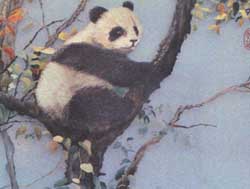| About China > Geography > Local Products |
|
|
Sichuan Shu Embroidery
Shu embroidery (Shu is the shortened form of Sichuan), also called "Chuan embroidery", is one of the four famous embroidery styles in China. It has enjoyed high reputation as "a treasure of Sichuan" ever since the Han Dynasty (206BC-220AD). The craft of Shu embroidery reached its peak during the Song Dynasty (960-1279). In the Qing Dynasty (1644-1911), many embroidery workshops were set up. After the founding of new China in 1949, Shu embroidery craft was greatly improved and it developed various new kinds.
Shu embroidery is renowned for its superb workmanship, smooth and bright in quality. It has strong expression and artistic effect. The features of it are said as "fine and smooth needlework, simple and elegant colors, graceful and easy lines and the traditional Chinese paintings' style ". Its needling characteristics lie in "the even stitches, bright threads, closeness and softness in texture, and both centrifugal and centripetal needling". The embroidery takes locally-produced colorful satin and threads as its materials.
The unique designs on Shu embroidery include flowers, birds, landscapes, fish, worms and human figures. Its products include pillowcases, embroidered slippers, mirror curtain, lace, wedding dress, scroll, hats and shoes, skirts, quilt facing, etc. It mainly employs the themes of auspicious happiness. |
||||
 |
